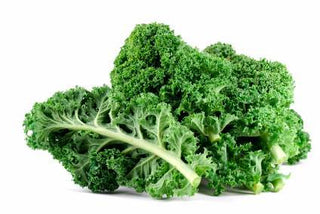(Brassica oleracea)
Kale is a peppery, mellow flavored form of cabbage with central leaves that do not form a head. Kale descends from wild cabbage that originated in Asia Minor and is considered to be closer in taste and form to its ancient ancestor than any other type of domesticated cabbage.
Known for its hearty qualities, kale can flourish in both cool and hot climates, and can even produce a crop in poor soil. Popular in Scandinavia, Germany, Holland, and Scotland, kale was brought to the United States in the early 17th century by Western European settlers.
There are three primary forms of kale, with each variety offering a different texture and flavor. Curly kale has deep green ruffled leaves and a pungent flavor. Ornamental kale, or salad savoy, has a milder flavor and tender texture with leaves that range in color from white to deep purple. Dinosaur or Tuscan kale has a sweeter taste and more delicate texture, with embossed deep blue green leaves.
Nutritional/Health Benefits
Kale is a dieter’s delight – this vegetable is highly nutritious yet very low in calories. Just one cup of chopped kale has 36 calories and 7 grams of carbohydrates of which 3 grams are from fiber. Unlike most vegetables, kale provides some protein (2 grams per serving).
Given its high nutritional content, kale can be considered a superfood. Kale is an excellent source of vitamin K, with just one cup providing 1,062 mcgs or 1328% of the recommended daily values. Additionally, kale is an excellent source of vitamin A, providing 17,709 IUs or 354% of daily values, primarily as beta-carotene, lutein, zeaxanthin and retinol. This vegetable is also an excellent source of vitamin C and manganese. Kale is a good source of the minerals copper and potassium.
For those concerned with adequate calcium intake, kale is a good source. One serving of kale contains 94 mg or more than 10% of the suggested daily intake of calcium. What’s more, the calcium in kale is readily absorbed – with an absorption rate superior to that of spinach and even milk.
Health Benefits
As a highly nutritious vegetable, kale stands out for its antioxidant, anti-inflammatory and anti-cancer nutrients. If you’re following an anti-inflammatory diet, kale should be tops on your list.
As with other brassicas, kale contains sulforaphane, a chemical believed to have potent anti-cancer properties. Although research indicates that there are more than 45 different antioxidant flavonoids in kale, kaempferol and quercetin are the most prevalent. This broad spectrum of phytonutrients is most likely the reason for the substantial health benefits of kale.
Health Risk
According to a “Shopper’s Guide to Pesticides”, a report published by the Environmental Working Group (EWG), kale is among the 12 foods with the greatest amount of pesticide residue. To avoid the health risk associated with pesticides, buy organically grown kale. For more information on the “dirty dozen” check out the EWG’s website.
Preparation and Storage
The kale harvest season extends primarily from the middle of winter to the beginning of spring but kale is readily available and can be found in most markets throughout the year. Because Kale flourishes in cool climates, the leaves are at their most tender and delicate during the winter harvest season.
When selecting kale, choose deep green bunches with small leaves. The small leaves are more tender and mild than their larger counterparts. Make sure to choose a bunch with a moist, fibrous stalk. Avoid kale with dry or wilted leaves.
Kale should be stored in the refrigerator. Warm temperatures compromise the flavor and cause leaves to wilt. In the refrigerator, store kale in a tightly sealed plastic bag. Stored in this way, kale will remain fresh for approximately five days. The longer the kale is stored the more bitter the flavor becomes. Fresh kale can easily be frozen. The greens freeze well and may even become sweeter. Do not wash greens prior to storing; exposure to water encourages spoilage.
When ready to use, douse the kale greens several times in a bowl of water. Dry thoroughly for salads, (a salad spinner works best), for cooking, greens can be patted dry. When preparing kale it is best to avoid boiling – this method of cooking reduces the anti-cancer compounds. Stir frying, steaming, or microwaving does not result in a significant loss of nutrients.
Recipes
Kale is an incredibly versatile green and can be used in dishes ranging from quiches to homemade chips. For an easy and delicious side dish try braise chopped kale and apples. Before serving, sprinkle with balsamic vinegar and chopped walnuts. For a light and flavorful dinner, combine chopped kale, pine nuts, and feta cheese with whole grain pasta drizzled with olive oil.
For a delicious, hearty and satisfying soup, try White Bean & Kale soup. For a healthy, crunchy take on snacking, try kale chips.
For more kale recipes, information and tips, check out 365 Days of Kale, written by Diana Dyer, a dietician and cancer survivor’s blog about all things kale!
Fun Facts
During World War II, the cultivation of kale in the U.K. was encouraged by the Dig for Victory campaign. The vegetable was easy to grow and provided important nutrients to supplement those missing from a normal diet because of rationing.

